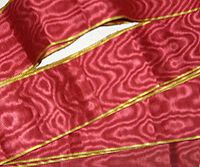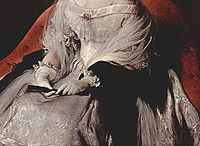
Moire (fabric)
Encyclopedia

Textile
A textile or cloth is a flexible woven material consisting of a network of natural or artificial fibres often referred to as thread or yarn. Yarn is produced by spinning raw fibres of wool, flax, cotton, or other material to produce long strands...
with a wavy (watered) appearance produced mainly from silk
Silk
Silk is a natural protein fiber, some forms of which can be woven into textiles. The best-known type of silk is obtained from the cocoons of the larvae of the mulberry silkworm Bombyx mori reared in captivity...
, but also wool
Wool
Wool is the textile fiber obtained from sheep and certain other animals, including cashmere from goats, mohair from goats, qiviut from muskoxen, vicuña, alpaca, camel from animals in the camel family, and angora from rabbits....
, cotton
Cotton
Cotton is a soft, fluffy staple fiber that grows in a boll, or protective capsule, around the seeds of cotton plants of the genus Gossypium. The fiber is almost pure cellulose. The botanical purpose of cotton fiber is to aid in seed dispersal....
and rayon
Rayon
Rayon is a manufactured regenerated cellulose fiber. Because it is produced from naturally occurring polymers, it is neither a truly synthetic fiber nor a natural fiber; it is a semi-synthetic or artificial fiber. Rayon is known by the names viscose rayon and art silk in the textile industry...
. The watered appearance is usually created by the finishing
Finishing (textiles)
In textile manufacturing, finishing refers to any process performed on yarn or fabric after weaving or knitting to improve the look, performance, or "hand" of the finished textile or clothing...
technique called calendering
Calendering
Calendering is a finishing process used on cloth where fabric is folded in half and passed under rollers at high temperatures and pressures. Calendering is used on fabrics such as moire to produce its watered effect and also on cambric and some types of sateens.In preparation for calendering, the...
. Moire effects are also achieved by certain weaves, such as varying the tension in the warp
Warp (weaving)
In weaving cloth, the warp is the set of lengthwise yarns that are held in tension on a frame or loom. The yarn that is inserted over-and-under the warp threads is called the weft, woof, or filler. Each individual warp thread in a fabric is called a warp end or end. Warp means "that which is thrown...
and weft
Weft
In weaving, weft or woof is the yarn which is drawn through the warp yarns to create cloth. In North America, it is sometimes referred to as the "fill" or the "filling yarn"....
of the weave, or by running the fabric through engraved copper rollers. Silk treated in this way is sometimes called watered silk.
Method of production

Changeable moire is a term for fabric with a warp of one color and a weft of another, which gives different effects in different lights.
Moire fabric is more delicate than fabric of the same type that has not gone through the calendering process. Also, contact with water removes the watermark and causes staining. Moire feels thin, glossy and papery due to the calendering process. Generally moire is made out of fabrics with a good body and defined ribs, such as grosgrain
Grosgrain
Grosgrain , also gros-grain and, rarely, gros grain, is a type of fabric characterized by its ribbed appearance. In grosgrain, the weft is heavier than the warp, creating prominent transverse ribs. It is called a "corded" fabric since the weft resembles a fine cord. Grosgrain is a plain weave...
. Fabrics with defined ribs show the watered effect better than smooth fabrics like satin
Satin
Satin is a weave that typically has a glossy surface and a dull back. It is a warp-dominated weaving technique that forms a minimum number of interlacings in a fabric. If a fabric is formed with a satin weave using filament fibres such as silk, nylon, or polyester, the corresponding fabric is...
. Taffeta
Taffeta
Taffeta is a crisp, smooth plain woven fabric made from silk or synthetic fibers. The word is Persian in origin, and means "twisted woven." It is considered to be a "high end" fabric, suitable for use in ball gowns, wedding dresses, and in interiors for curtains or wallcovering. There are two...
also works well. Fabrics with defined enough ribs can be calendered with smooth rollers and produce a moire finish; however generally the rollers have ribs that correspond to the grain of the fabric. The moire effect may be obtained on silk, worsted, or cotton fabrics, though it is impossible to develop it on other than a grained or fine corded weave.
Moire can also be produced by running fabric through engraved copper rollers.
Etymology

Textile
A textile or cloth is a flexible woven material consisting of a network of natural or artificial fibres often referred to as thread or yarn. Yarn is produced by spinning raw fibres of wool, flax, cotton, or other material to produce long strands...
, traditionally of silk
Silk
Silk is a natural protein fiber, some forms of which can be woven into textiles. The best-known type of silk is obtained from the cocoons of the larvae of the mulberry silkworm Bombyx mori reared in captivity...
but now also of cotton
Cotton
Cotton is a soft, fluffy staple fiber that grows in a boll, or protective capsule, around the seeds of cotton plants of the genus Gossypium. The fiber is almost pure cellulose. The botanical purpose of cotton fiber is to aid in seed dispersal....
or synthetic fiber
Synthetic fiber
Synthetic fibers are the result of extensive research by scientists to improve on naturally occurring animal and plant fibers. In general, synthetic fibers are created by forcing, usually through extrusion, fiber forming materials through holes into the air, forming a thread...
, with a rippled or 'watered' appearance.
The history of the word moiré is complicated. The earliest agreed origin is the Arabic mukhayyar (مُخَيَّر in Arabic, which means chosen), a cloth made from the wool of the Angora goat
Angora goat
The Angora goat is a breed of domestic goat that originated in Ankara , Turkey and its surrounding region in central Anatolia...
, from khayyara (خيّر in Arabic), 'he chose' (hence 'a choice, or excellent, cloth'). It has also been suggested that the Arabic word was formed from the Latin marmoreus, meaning 'like marble'. By 1570 the word had found its way into English as mohair
Mohair
Mohair usually refers to a silk-like fabric or yarn made from the hair of the Angora goat. The word "mohair" was adopted into English before 1570 from the Arabic: mukhayyar, a type of haircloth, literally 'choice', from khayyara, 'he chose'. Mohair fiber is approximately 25-45 microns in...
. This was then adopted into French as mouaire, and by 1660 (in the writings of Samuel Pepys
Samuel Pepys
Samuel Pepys FRS, MP, JP, was an English naval administrator and Member of Parliament who is now most famous for the diary he kept for a decade while still a relatively young man...
) it had been adopted back into English as moire or moyre. Meanwhile the French mouaire had mutated into a verb, moirer, meaning 'to produce a watered textile by weaving or pressing', which by 1823 had spawned the adjective moiré. Moire and moiré (mwɑːˈreɪ or ˈmɔreɪ) are now used somewhat interchangeably in English, though moire is more often used for the cloth and moiré for the pattern
Moiré pattern
In physics, a moiré pattern is an interference pattern created, for example, when two grids are overlaid at an angle, or when they have slightly different mesh sizes.- Etymology :...
.
History
During the Middle AgesMiddle Ages
The Middle Ages is a periodization of European history from the 5th century to the 15th century. The Middle Ages follows the fall of the Western Roman Empire in 476 and precedes the Early Modern Era. It is the middle period of a three-period division of Western history: Classic, Medieval and Modern...
moire was held in high esteem and was, as currently, used for women’s dresses, capes, and for facings, trimmings, etc. Originally moire was only made of silk
Silk
Silk is a natural protein fiber, some forms of which can be woven into textiles. The best-known type of silk is obtained from the cocoons of the larvae of the mulberry silkworm Bombyx mori reared in captivity...
taffeta
Taffeta
Taffeta is a crisp, smooth plain woven fabric made from silk or synthetic fibers. The word is Persian in origin, and means "twisted woven." It is considered to be a "high end" fabric, suitable for use in ball gowns, wedding dresses, and in interiors for curtains or wallcovering. There are two...
, however now cotton and synthetic fiber
Synthetic fiber
Synthetic fibers are the result of extensive research by scientists to improve on naturally occurring animal and plant fibers. In general, synthetic fibers are created by forcing, usually through extrusion, fiber forming materials through holes into the air, forming a thread...
s such as viscose
Viscose
Viscose is a viscous organic liquid used to make rayon and cellophane. Viscose is becoming synonymous with rayon, a soft material commonly used in shirts, shorts, coats, jackets, and other outer wear.-Manufacture:...
(rayon) are also used. Moire has been worn throughout the late 19th century and early 20th century, and is still used for evening dresses and wedding gowns.

